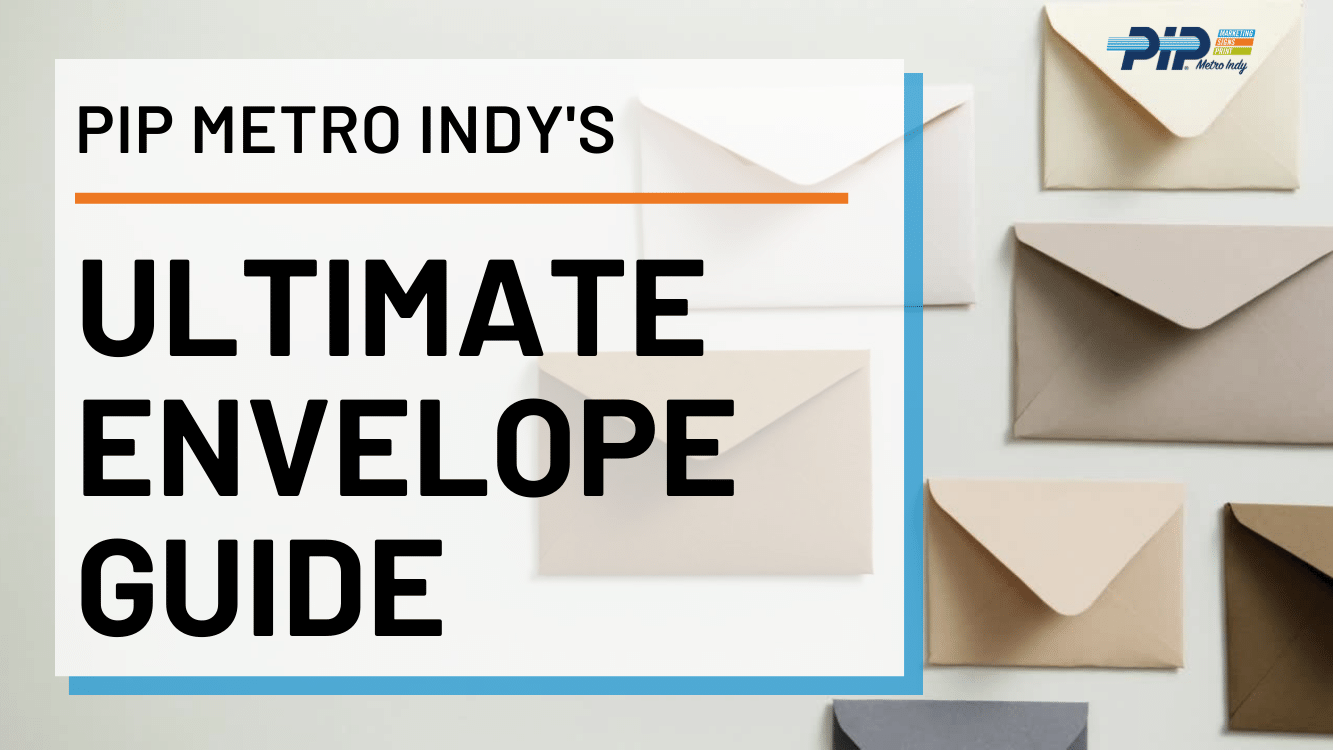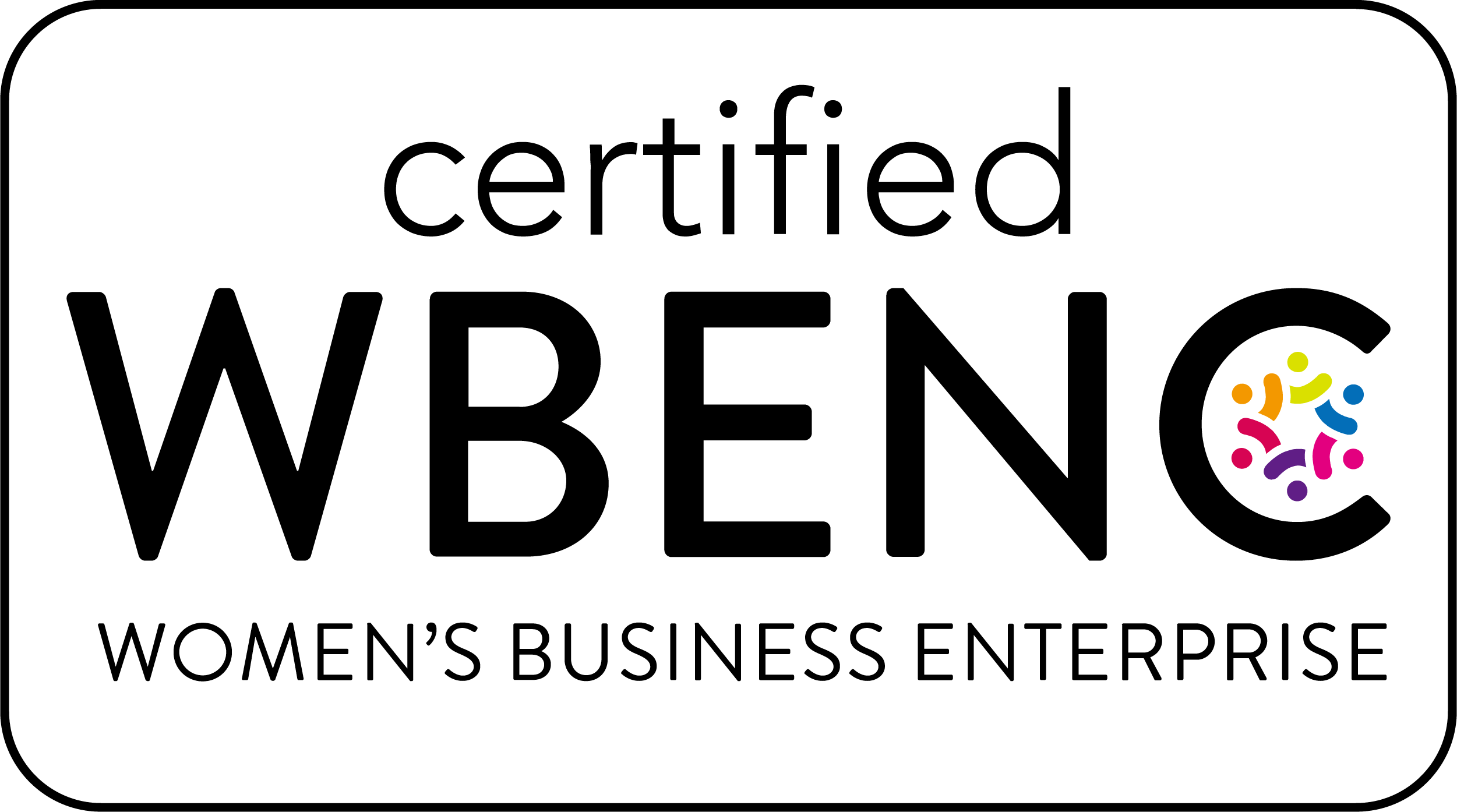
Choosing the right envelope for your next project can be a confusing process, but the PIP Metro Indy team is here to help guide you to the right choice for your needs. While some envelopes are great for mailings, others might be a better choice for office mail such as invoices or formal letters. As far as the envelope naming goes, the numbering system or industry-specific naming conventions can be a struggle to figure out which one will best suit your needs. Below is a quick guide to help you compare envelope sizes, materials and closures.
Regular/Business/Stationary Envelopes
Regular envelopes can be found under many names, but they are most commonly known as “regular,” “business,” or “stationary” envelopes. These envelopes are most commonly used for small mailings such as letters or interoffice materials. The #10 (4.125″ x 9.5″) envelope is the industry standard for business mailings, as this size can hold an 8.5″ x 11″ letter that is tri-folded. A #9 envelope (3.875″ x 8.875″) is commonly used as a reply envelope for invoices or business mailings, where the #9 envelope is stuffed inside the #10 envelope for the recipient to mail something in reply to the sender.
Other popular regular envelopes include (list via Supplies Shops):
- #5 Regular Envelopes (3-1/8″ x 5-1/2″) – Same size as a coin envelope, but side opening. It can be mailed inside of other envelopes or used to store smaller items. This envelope cannot be mailed by itself.
- #6-1/4 Regular Envelopes (3-1/2″ x 6″) – The smallest commercial envelope size available, it’s just the right size for everyday usage; perfect for mailing small items such as a folded personal check. Use to store tickets for an upcoming event or store reminders, coupons, recipes, social security cards, or other items that require organization in your personal records.
- #6-3/4 Regular Envelopes (3-5/8″ x 6-1/2″) – Great for personal or corporate business. This size could be used for invoices, sales pieces, checks, or correspondence. These are also known as remittance envelopes.
- #7 Regular Envelopes (3-3/4″ x 6-3/4″) – The ideal model that is suitable for short business correspondence or home office needs.
- #7-1/2 Regular Envelopes (3-15/16″ x 7-1/2″) – It can be mailed inside of other envelopes and used as a return envelope or be used as a mailer for smaller envelopes.
- #8-5/8 Regular Envelopes (3-5/8″ x 8-5/8″) – Popular as business payment envelopes, it is also ideal for checks (no need to fold business-sized checks).
- #9-5/8 Regular Envelopes (4-1/2″ x 9-5/8″) – These are slightly larger than the #9 envelope,so it can fit more folded pages.
- #11 Regular Envelopes (4-1/2″ x 10-3/8″) – The larger size allows for more folded pages, storage, and can act as an outer envelope to the #10 envelope being used as a return envelope.
By definition, a “regular” envelope means it has a solid front (with no window) and a flap on the back. They can have special features inside, including a security tint or even a pre-moistened adhesive flap or sealing. While they are most commonly white, they can come in a large variety of colors for all of your project needs.
Window Envelopes
Window envelopes have a clear opening that allow the content inside to be seen, which typically includes a mailing address in the lower left-hand corner. Single window envelopes have one opening for a mailing address to be seen, but a double window envelope has an opening to see the sender’s return address as well. Full face window envelopes are also an option – typically used for insurance companies or offical documents – where the entire front left section of the envelope has a view of the contents inside.
Common window envelope sizes (list via Supplies Shops):
- #6-3/4 Window Envelopes (3-5/8″ x 6-1/2″)– Fits a personal check.
- #8-5/8 Window Envelopes (3-5/8″ x 8-5/8″) – Great for sending check payments from accounting software like Quickbooks.
- #9 Window Envelopes (3-7/8″ x 8-7/8″)– This size fits comfortably inside a standard #10 envelope, so is often used as a return envelope.
- #10 Window Envelopes (4-1/8″ 9-1/2″)– Standard business envelope. Fits an 8 1/2″ x 11″ piece of paper folded in thirds.
To run window envelopes on our digital machines at PIP Metro Indy, we special order digital compatible envelopes that can withstand the temperatures inside our Xerox machine so the window plastic does not warp or melt inside the machine.
Square Envelopes
Arguably the most stylish enevelope choice, square envelopes are square and symmetrical. While most square envelopes have a square flap on the back, but you can find some with large triangle contour flaps – a great fit for wedding invites! The sizes range from 5″ x 5″ up to 13″ x 13,” and they are most commonly used for formal invitations such as weddings or gala invites and commercial announcements. These are great for unique, festive branding opportunites. These do come at an additional postage cost due to their shape, so we highly recommend verifying the postage amount before sending these envelopes out in the mail.
Catalog Envelopes (Catalog envelope example)
Also known as open end envelopes, catalog envelopes have an envelope flap on the short end of the envelope (left or right-side opening). Catalog envelopes are available with or without windows, and are high-quality envelopes that come in white, brown kraft, or colored options. In addition to choosing your colors, you can choose between paper or Tyvek material (a 100% synthetic material from polyethylene fibers – essentially thin plastic). Depending on what you are putting inside the envelope, you can also choose a closure mechanism that will keep everything safe and secure.
Catalog envelopes are most commonly used for heavy mailing/shipping requirements, such as: magazines, catalogs, sales literature, booklets and more! The sizes can range from 2.5″ x 4.25″ to 22″ x 27″ to fit just about everything.
Booklet Envelopes (Booklet envelope example)
Booklet envelopes open from the top and are made for large and thick mailings, such as reports, brochures, catalogs and literature. Booklet envelopes and catalog envelopes are incredibly similar, it usually comes down to a matter or envelope opening preference. These envelopes are ideal for items that shouldn’t be folded to fit into a standard envelope and envelope sizes range from 4.1875″ x 9.5″ to 12″ x 16.”
We offer a wide range of booklet envelopes both with windows – ranging in size from small corner windows to large showcase windows – and without windows to best suit your project’s needs.
Remittance Envelopes
Order your remittance envelopes from the Supplies Shops and save big on bulk orders. Remittance and collection envelopes are used by churches, charities, and schools for donations. We carry a wide variety of remittance envelopes in different colors, sizes, and styles. Choose from #6-1/4 envelopes, #6-3/4 envelopes, or #9 envelopes for your convenience. These are most commonly used for return envelopes, mail orders, subscriptions, donations and coupons.
- #6-1/4 Remittance Envelopes (3.5″ x 6.25″)– These are ideal for mail orders, subscriptions, donations and much more.
- #6-3/4 Remittance Envelopes (3.625″ x 6.5″)– This is the most common remittance envelope for business projects. There is a large printing area on these, as we can print on both the front and open flap back of these envelopes.
- #9 Remittance Envelopes (3.875″ x 8.875″)– These are commonly put inside #10 envelopes for return envelopes.
Coin Envelopes
Despite the decline of coin and paper money, coin envelopes are still very much in use today. Coin envelopes are made of heavy-duty paper that can hold a large number of coins without breaking under the weight. To fit the wide variety of money sizes on the market, we can assist you with envelopes from #00 to #7H to fit your money collection needs.
If you’re looking for small envelopes to store other items, coin envelopes are also ideal for storing and organizing items like: small machine parts, stamps, paper fasteners, jewlrey beads and many other small items.
Specialty Envelopes
There are many times a standard envelope might not fit your communication, marketing or sales goals. Speciality envelopes are made of alternative materials or with a different design, but can help fit a specific need.
Specialty envelopes help you achieve specific communication, marketing, and sales goals that cannot be met by common standard envelopes. There are also times when the standard envelope size is fine, but you prefer to use an alternative envelope design, which suits your purposes much better. Specialty envelopes are different in material or design from standard envelopes, and are designed to make business operations go more smoothly.
Some of the popular specialty envelopes are:
- Offering Envelopes (3.125″ x 6.25″)– These are ideal for churches, fundraising initatives, charity donations, or really any type of money collection.
- Bank Deposit Envelopes (3.25″ x 7″, 3.5″ x 7″, 3.75″ x 7″)– A larger version of coin envelopes, these are ideal for checks, cash or other documents.
- Tax Form Envelopes (Variety)– These envelopes are designed to display addresses when tax forms are inserted.
- Money Gift Envelopes (2.75″ x 6.3125″)– Ideal envelopes for birthdays, graduations and holidays.
- Door Hanger Envelopes (4.5″ x 10.25″)– Door Hanger Envelopes are great for marketing materials (such as door hangers), receipts and invoices.
- Jewelry Envelopes (3.125″ x 5.5″, 3.625″ x 6″)– These are great for jewelry and/or parking tickets.
Once you have determined your envelope type and size, you’ll need to choose how you would like your envelopes to seal. While these options are not available for every single envelope choice, these are the most common envelope closure types:
- Remoistening Seal – A gum seal activated by moistening the flap for a permanent seal.
- Split Seal – A gum seal split into sections and activated by moistening the flap for a permanent seal; better for storing envelopes in humid conditions.
- Flip-Stik Seal – Latex adhesive applied on two flap surfaces and folded to keep them separated until sealing; no moisture required.
- Pres-Stik® – Self-adhering latex adhesive applied to two surfaces that seals on contact when joined.
- Kwik-Tak® – Release tape liner applied over a resin adhesive pressure sensitive seal. Remove liner and press flap down to seal; no moisture required.
- Multi-Tak™ – Seal tape closure for reusable sealing; can be printed after conversion.
- Clasp – Reinforced, double-pronged metal clasp for added security. Should not be run through automated processes after conversion.
- String & Button – Tie-down closures ready for repeat opening or secured sealing.
Still need some additional assitance picking out the best envelope for your project, send us a message! We’d be happy to discuss the best options with you to make your project pop.


